
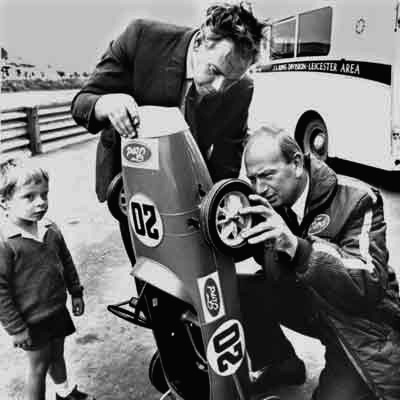
Cosworth Engines
[ Vol.1 | Vol.2 | Vol.3 | Vol.4 | Vol.5 ]
[ Vol.1 - Modified OHV | SCA | FVA | BDA ]
[ Vol.2 - DFV | DFV in Japan ]
[ Vol.3 - Fomula 1 | Indy/Champ car ]
[ Vol.4 - inline 4 ]
[ Vol.5 - Others ]
| Fomula 1 engines after DFV era |
FORD BADGED
| 1.5L TURBO | ||||||||
| TEC (GBA) |
1986-1987 | V6 | 120 | (turbo) | - | 1497 | 11000-12000 | 850-1000 bhp |
| 3.5L V8 | ||||||||
| HB (Series I 〜 VIII) |
1989-1994 | V8 | 75 | 96 x 60.4 | 140 kg 130 kg (1994) |
3497 | 11500-13800 | 615-730 bhp |
| 3.0L V8 | ||||||||
| ED (EDM ED 2/4) |
1995-1997 | V8 | 75 | 94 x 53.95 | 132 kg | 2999 | 13800 | 580-600 bhp |
| 3.5L V8 & 3.0L V10 | ||||||||
| ZETEC-R (EC) |
1994 | V8 | 75 | 96 x 60.4 | 135 kg | 3497 | 13800 | 740 bhp |
| ZETEC-R (ECA) |
1995-1997 | V8 | 75 | 94 x 53.9 | 135 kg | 2994 | 14000 | 610-630 bhp |
| ZETEC-R (JD) |
1996-1999 | V10 | 72 | 89 x 48.1 | - | 2998 | 15800-16500 | 670-690 bhp (1997:720 bhp - race 730 bhp - qualifying) |
| ZETEC-R (VJ) |
2000 (Fondmetal) |
V10 | 72 | 89 x 48.1 | 120 kg | 2998 | 15800-16500 | 670-690 bhp |
| ZETEC-R (VJM) |
2001 (European) |
V10 | 72 | 89 x 48.1 | - | 2998 | 15800-16500 | 670-690 bhp |
| 3.0L V10 | ||||||||
| CR-1 | 1999 2001 (European) |
V10 | 72 | - | 100 kg | 2998 | 16500 (2001) | 770 bhp (2001) |
COSWORTH BADGED
| CR-2 | 2000 | V10 | 72 | 97 kg | 2998 | 18000 | - | |
| CR-3 | 2001-2003 | V10 | 72 | 97 kg | 2998 | 18500 | 840 bhp | |
| CR-3L | 2005 | V10 | 72 | - | 2998 | - | - | |
| CR-4 (FORD RS1) | 2002 | V10 | - | 105 kg | 2998 | 18000 | - | |
| CR-5 (FORD RS2) | 2003 | V10 | 90 | 94 kg | 2998 | 18300 | 800 bhp | |
| CR-6 | 2004 | V10 | 90 | 94 kg | 2998 | - | - | |
| 3.0L V10 | ||||||||
| CK2004 | 2005 | V10 | 72 | - | 2998 | - | - | |
| TJ2005 | 2005 | V10 | 90 | - | 2998 | 18000 | 900 bhp | |
| TJ2006 | 2006 | V10 | 90 | - | 2998 | 16700 | - | |
| 3.0L V8 | ||||||||
| CA2006 | 2006 | V8 | 90 | - | 2998 | - | - | |
| 2.4L V8 | ||||||||
| CA2010 (CA2011) |
2010-2011 | V8 | 90 | 95 kg | 2400 | 18000 | - | |
1986-87: TEC(GBA) - 1.5L V6 Turbo
Cosworth experimented with turbocharged BD derivatives, before settling on an all-new turbocharged 1,500 cc V6 engine to be badged as the Ford TEC (internally it was known as the GB-series).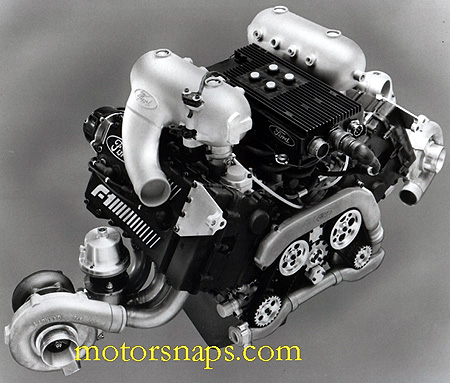
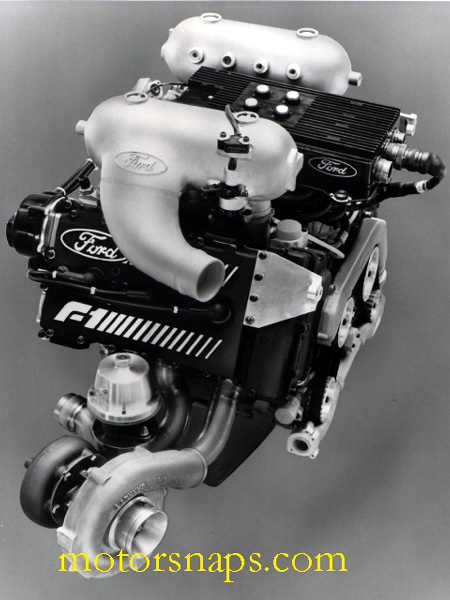
This had a long development history but raced only briefly, in 1986, with the Haas Lola team and in 1987 with the Benetton Formula team.
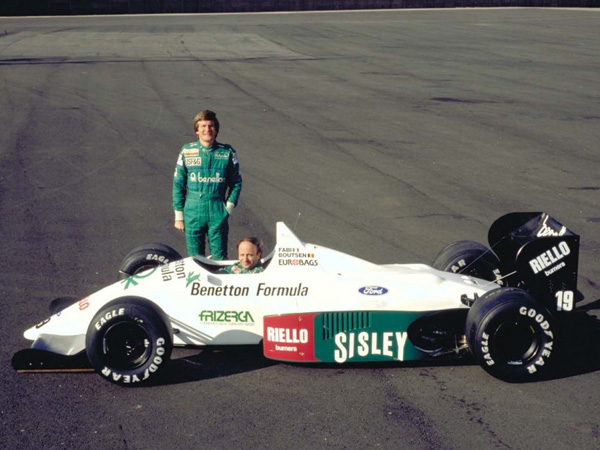
1987 Benetton B187 Cosworth
1989-94: HB 75°V8
長年F1に君臨し続けたDFVエンジンが、ターボエンジンによって駆逐された後、その発展系である「DFZ」、「DFR」がカスタマー供給されていたが、DFVベースから脱却した新設計の「HBシリーズ」をベネトンにワークス供給することになった。1991年にはジョーダンに供給されたのをきっかけに、1992年からはDFRに代わるカスタマーエンジンとなった。
HBエンジンは後ろにローマ数字を振ってバージョンを示している。最新型エンジンは基本的にワークス契約のベネトンに供給され、カスタマー契約のチームには原則ワークスの1〜2バージョン落ちのスペックのエンジンが供給された。
1993年、ベネトン、マクラーレン、フォード3者の合意により、第9戦イギリスGPからはマクラーレンにもワークス供給の体制が取られた。
The final DFV/DFZ/DFR replacement, the 3,500 cc HB V8 was introduced with the Benetton team midway through 1989, winning the Japanese Grand Prix that year.
This exploited a narrower vee-angle than the DFV. As the works team, Benetton maintained exclusivity with this model through the rest of 1989 and 1990. 1991 saw the introduction of customer units, two specifications behind their works equivalents.
In 1991, these were supplied to the fledgling Jordan Grand Prix outfit, and for 1992, Team Lotus. 1993 saw the customer deal extended to McLaren, who won five Grands Prix with Ayrton Senna that year.
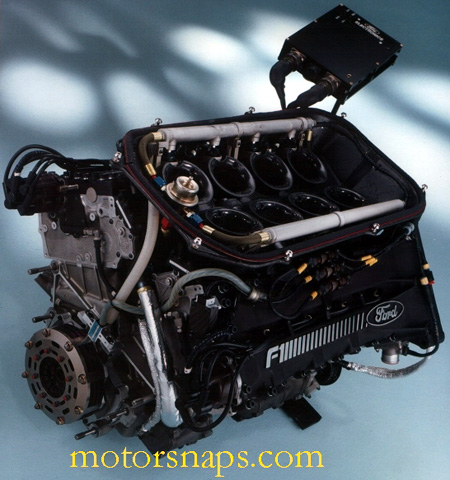
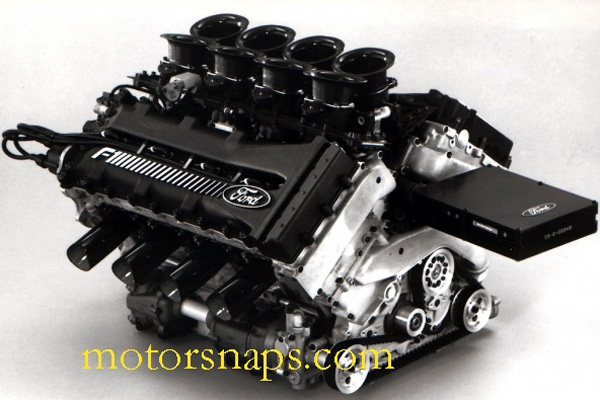
HB on sports car
1991-92: Jaguar XJR-14
A Jaguar-badged version of the HB was briefly used in sports car racing, fitted to the extremely successful Jaguar XJR-14.当時のジャガーはフォードの傘下企業であったためF1で使用していたエンジンであるフォード・コスワース・HBエンジンを転用することができた。その中でも信頼性のある通称“シリーズ5”と呼ばれるエンジンにジャガーのカムカバーをつけ、ジャガーV8とした。開発、メンテナンスはコスワースではなくTWR自ら行っている。
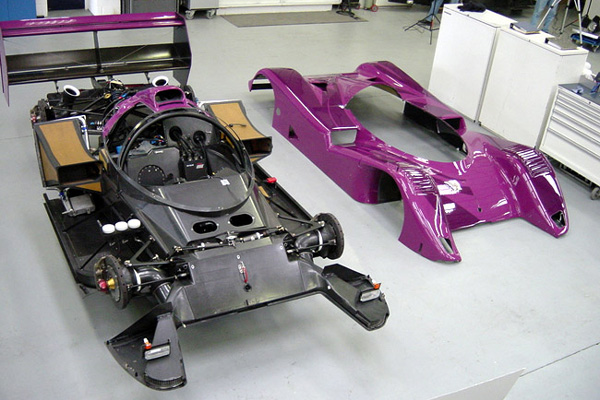
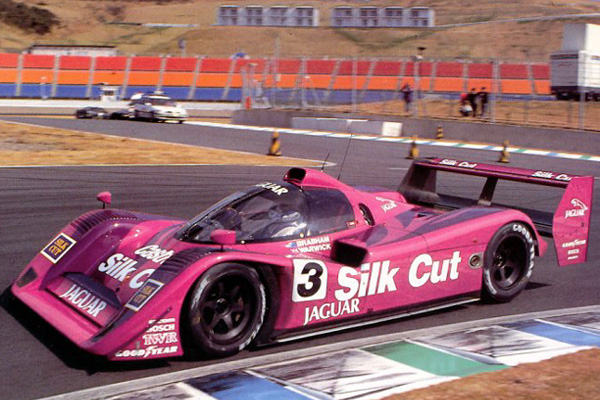
1991-92: VB - 3.5L V12: Cancelled
開発当時のトレンドであった12気筒をコスワースも開発していたが、まもなくV10へ時流は変わり、開発計画は中止となった。その開発内容は次期V8、ZETEC-R V8エンジンにフィードバックされる。
以下の記述では1989年となっているが・・・
The Ford Cosworth 3.5-litre-V12-cylinder project 1989: In the late season 1989 Benetton - then the official partner of Ford in F1 - announced, together with the engagement of John Barnard and Nelson Piquet, that Ford is developing a V12 to replace the old V8. This V12 machine really was developed and tested but it was never raced in a GP. Apparently the V8 concept was good enough - Schumacher won his first title with such an engine in 1994.
1994-95: AC for F3000
1994年、国際F3000に、まったく新しく、軽量・コンパクト化した「コスワースAC」が投入された。
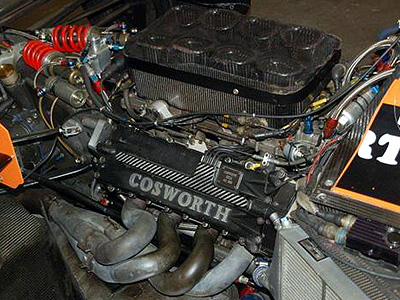
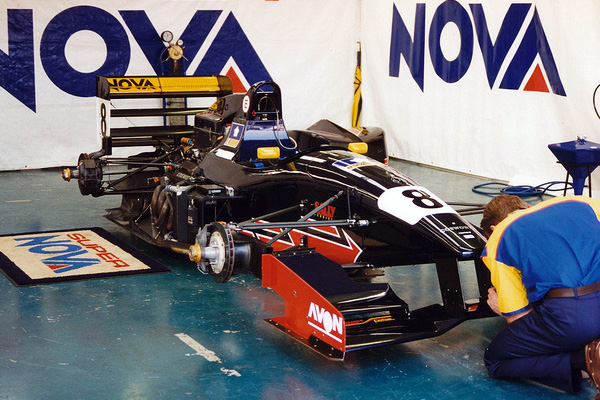
1995 International F3000 Champion - Vincenzo Sospiri - Super Nova Reynard Cosworth 95D
ED
1995年に行われたレギュレーション改定で、エンジン排気量が3,500ccから3,000ccに縮小された。それを受けて、HBエンジンを排気量3,000ccに対応させたのがEDエンジンである。1995年、ミナルディ、シムテック、パシフィック、フォルティの4チームへカスタマー供給された。供給開始当初より、ミナルディにパワー不足を酷評されるなどし、 1997年のティレル(とシーズン途中まで参戦していたローラ)への供給で役目を終えた。
1995年の開幕前からエンジンの性能不足に気付いたミナルディは、イタリアの電子部品メーカーであるマニエッティ・マレリと共同で独自のECUを開発し、エンジン名称をEDMとしていた。
コスワースはワークス用として、同じ3,000cc V8で設計の全く異なるZETEC-Rも同時並行で開発していた。
ZETEC-R
1991年から1992年にかけて、セラミックス素材を多用した軽量なV12エンジンの開発を行っていたが、開発を断念。その開発内容をフィードバックさせたエンジンが、ZETEC-R V8エンジンである。1994年、ベネトンにワークス供給、ミハエル・シューマッハによる初のドライバーズチャンピオン獲得をサポートした。
1995年、ベネトンが使用エンジンをルノー V10へ変更したため、ザウバーへV8エンジンを供給。同年から排気量の規定が3,500cc以下から3,000cc以下へと変更された。
1996年、V10エンジンをザウバーへワークス供給。
1997年からは、ジャッキー・スチュワートとその息子ポール・スチュワートが率いるスチュワート・グランプリへV10エンジンをワークス供給。
1998年からは、ティレルやミナルディにカスタマー供給が開始された。ミナルディは、2001年までVJエンジン、フォンドメタルV10などといったように名前を変えながら使用し続けた。
1999年、スチュワートに新型ワークスエンジンであるCR1エンジンが供給され、ZETEC-Rはカスタマー供給のみとなった。
CR

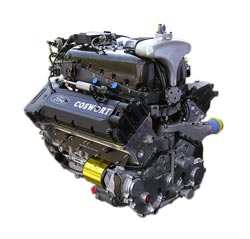
CR3(V10 72deg. 3.0L) CR5(V10 90deg. 3.0L)
投入初年度の1999年、スチュワートのジョニー・ハーバートによって優勝を、同チームのルーベンス・バリチェロによってポールポジションを得たが、このエンジンではこれが唯一の獲得であった。
2000年から、フォードがスチュワートを買収しジャガー・レーシングとして参戦、コスワースブランドでワークス供給していたが、活動は2004年で終了した。(フォードブランドとしては2003年にジョーダン・グランプリに供給しているが、カスタマー待遇)。
2002年にはアロウズに、カスタマー供給された。
2003年から2004年、ミナルディとジョーダン(フォード名義)にカスタマー供給された。
2003年、ブラジルGPのジャンカルロ・フィジケラ(ジョーダン)が荒れに荒れたレースで優勝したが、現在F1におけるフォード・コスワースエンジンの最後の勝利となっている(フォード・コスワースエンジンとしてF1通算176勝)。
2004年、ミナルディに供給されたCR-3Lは、CR-3に1レース分の400kmの耐久力を持たせたエンジン(LongのL)である。
2001-2003: CR-3
Cosworth has subsequently made several 3,000 cc V10 engines for a number of Formula One teams. The Stewart Grand Prix team effectively became the Ford works team, and used Cosworth CR-1 engines from its first season in 1997.Over the next few years Ford had increased its involvement with the Stewart team, and finally bought the team, renaming it Jaguar Racing for 2000. Jaguar pulled out of F1 at the end of 2004, but the team (renamed Red Bull Racing) continued to use Cosworth V10 engines until switching to a Ferrari V8 for 2006. Minardi also used re-badged Cosworth engines until 2005.
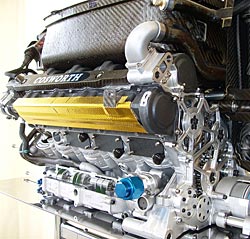
CK2004,TJ2005,TJ2006
2004年末にフォードがジャガーとコスワースを売却した。2005年第3戦にミナルディに搭載されたCK2004エンジンは前年使用したCR-3Lを、モディファイしたエンジンである。
2005年第4戦からとレッドブルに開幕以来搭載されていたTJ2005シリーズ10エンジンはCR-6を、2レース持つようにモディファイしたエンジンである。シーズン途中でレッドブルにはシリーズ14のアップデートエンジンが供給された。
2005: TJ2005

TJ2005
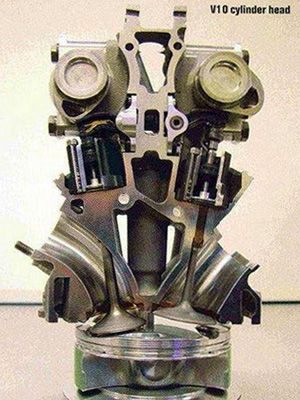
ニューマチックバルブ(バルブスプリングがないことに注意)
CA2006
2006年、新たにエンジン供給を受けることとなったウィリアムズにはV8エンジンであるコスワースCA2006エンジンが供給された。
2006年、ミナルディを買収したトロ・ロッソには前年にレッドブルが使用したエンジンに回転数制限を加えたTJ2006シリーズ14エンジンが投入された。これはV8エンジンの供給を受けられそうに無いチームが暫定的にV10の性能制限版を使用できるとの救済措置にのっとって使用された。ミナルディチームへは、2005年(コスワースTJ2005シリーズ10)までエンジンを供給し続けた。
2007年からはウィリアムズはトヨタエンジン、トロ・ロッソはレッドブルから譲り受けたフェラーリエンジンとなっため、F1 からコスワースの名前が消滅した。
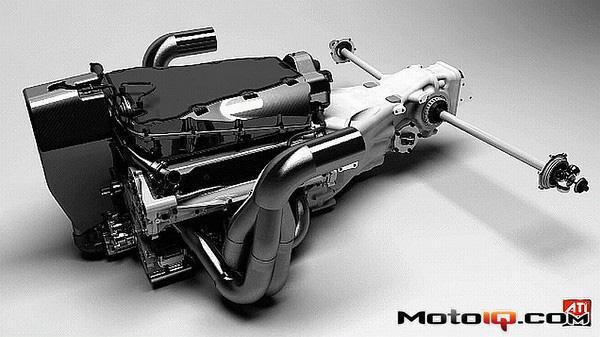
When the checkered flag came out at the end of the 2006 Brazilian Grand Prix, it brought down the curtain, at least temporarily, on a 39 year Formula One odyssey that took Cosworth from a dream to becoming the second most successful manufacturer in the Formula's history. Only Ferrari has won more races and no one has supplied more teams.
It was a particular irony that Cosworth's final season in F1 saw it produce its best engine since the heady days of the DFV, Keith Duckworth's brilliant piece of innovative engineering which was the cornerstone on which the business was developed.
The 2006 CA engine was acknowledged throughout the Formula One paddock as the benchmark against which all the new V8's had to be measured. With 20,000 rpm available for qualifying from the first race of the season and 20,000 rpm available for the whole race by the end of the season Cosworth was rightly proud of the CA but race results were disappointing.
Williams began testing the new CA2006 2.4-litre V8 in November 2005, and used the Cosworth V8 engines for the 2006 season. In the same year, Scuderia Toro Rosso used detuned V10 engines based on the 2005 units.
In 2007, however, the company was left without a partner when Williams chose to switch to Toyota power, and Scuderia Toro Rosso made the switch to Ferrari engines (as used in 2006 by their mother team Red Bull Racing).
In Max Mosley's letter following the withdrawal of Honda from Formula One in December 2008, it was announced that Cosworth had won the tender to provide a standard engine to any interested participants.
The new engine would become the standard design and manufacturers could opt to use whole units, construct their own from designs provided by Cosworth, or produce their own engine with the caveat that it be limited to the same power as the new "standard" engine.
2010: CA2010
2008年10月17日、FIAは2010年から導入するスタンダードエンジンの入札を開始しコスワースはイルモア、メカクローム、ザイテック、 ジャッド等と共に入札に加わった。12月5日、FIAはコスワースとのエンジン供給契約を発表した。2009年6月12日にFIAが2010年のF1世界選手権のエントリーリストを発表。新規参入となるUSGPE、カンポス・グランプリ、 マノー・グランプリの3チームがコスワースからエンジン供給を受ける。
トヨタとの契約を打ち切ったウィリアムズは2010年のF1世界選手権より、再びコスワースからエンジン供給を受ける。BMW撤退によってロータスF1チームが参戦することとなり、こちらもコスワースから供給を受けることとなった。
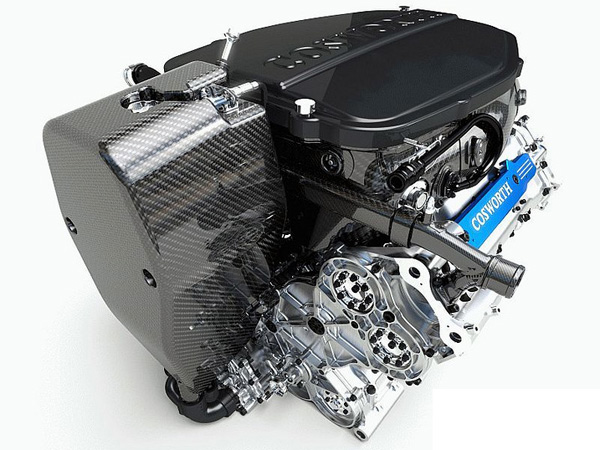
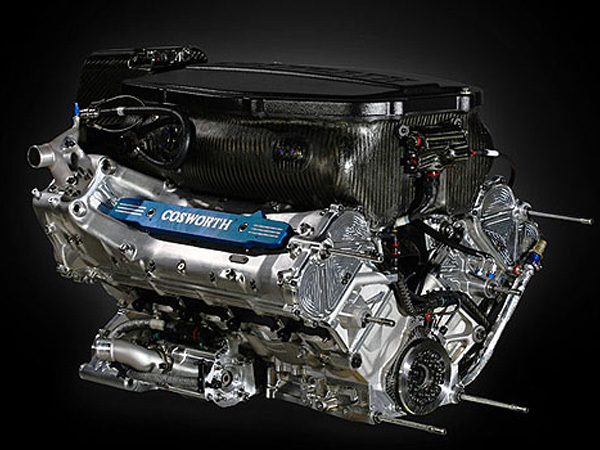
In 2010 Cosworth returned as the engine supplier for Williams and three new teams; Hispania Racing, Lotus F1 Racing and Virgin Racing. The CA2010 is the same 2.4-litre V8 base of the CA2006 used by Williams, but has been re-tuned for the current 18,000 rpm limit required on all engines, down from its original 20,000 rpm implementation.
First units were ready and shipped to teams in mid-January for fitting 2 weeks prior to first track testing for the year.
2011: CA2011
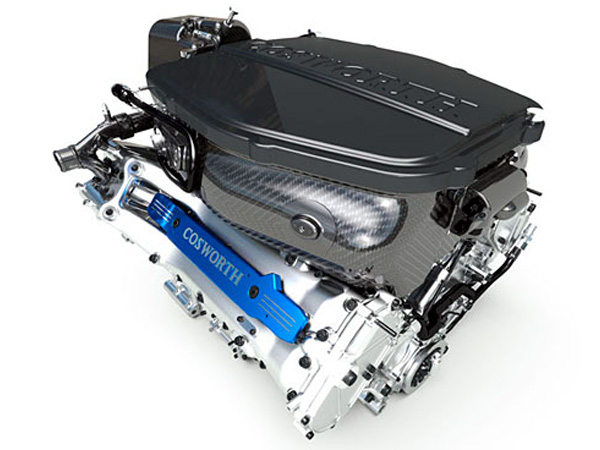
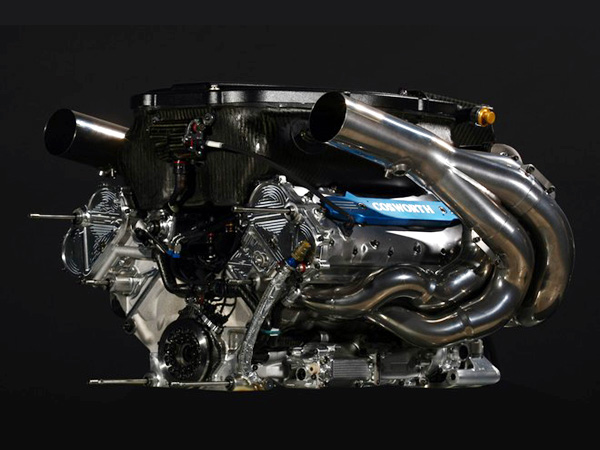
| Indy/Champ car engines after DFX era |
The history of CART, Champ car, and IRL1911-: Indy carインディカー・シリーズの華であるインディアナポリス500マイル・レース(インディ500)の第1回大会は1911年に開催され、100年の歴史を持つ。初期のインディ500で活躍したアメリカ・ブランドは、マーモン、ビュイック、マーサー、ナショナルだが、間もなく、プジョー、ドラージュ、メルセデス・ベンツ、フィアットが大西洋を越え参戦してきた。 第1次世界大戦後はフロンテナック、デューセンバーグ、ミラーなどのアメリカン・ブランドが勝っている。この時代は少量生産の市販スポーツカーやそれを改造したマシンが競い合った。 1930年代になるとレース専用マシンの時代が始まる。そのとき登場してきたのがアメリカのオッフェンハウザーであった。4200cc直列4気筒で、愛称はオッフィー。オッフィーは、1935年から1976年まで41年間で27勝し、そのうち47年から64年まで18連勝という、いまだに破られることのない記録を残した。
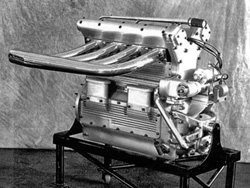 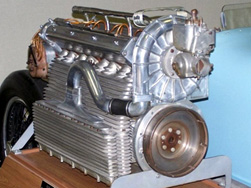 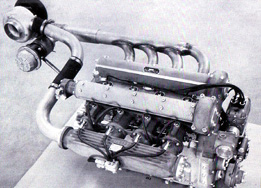 Offenhauser NA, Supercharged, Turbo
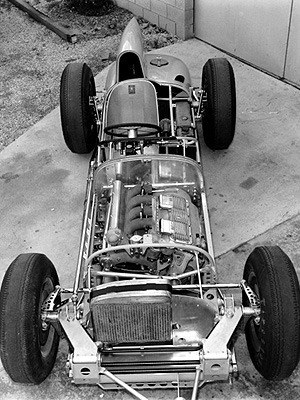 1958 Front engine (Offy) Indy car
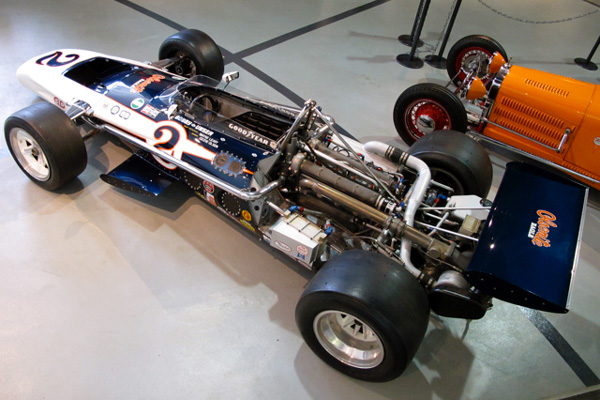 1971 Mid engine (Offy) Indy car このオッフィーに挑んだのがフォードであった。1965年にミドシップ・マシン、ロータス38にフォード製4.2L DOHC4バルブNAエンジンが搭載されて優勝すると、1970年代後半までオッフィー対フォード激闘の時代が続く。これに勝利したフォードは、コスワースとのパートナーシップを組んで勝ち続ける。(1975年にDFVをベースに2.6LターボとしたコスワースDFXをデビューさせる)
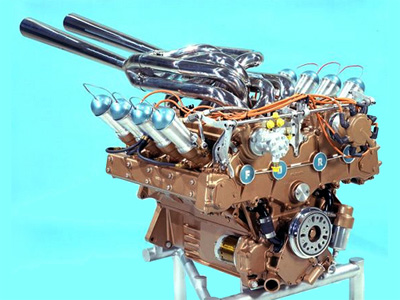 1965 FORD DOHC V8
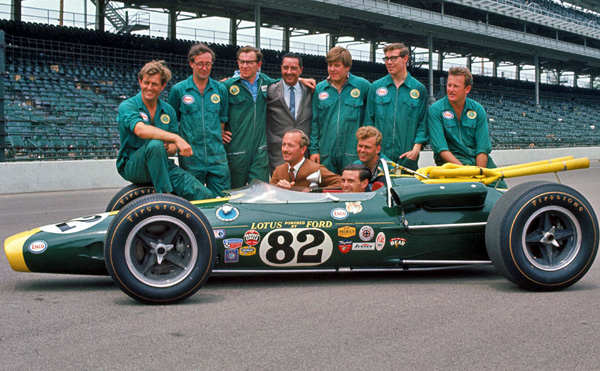 1965 Lotus 38
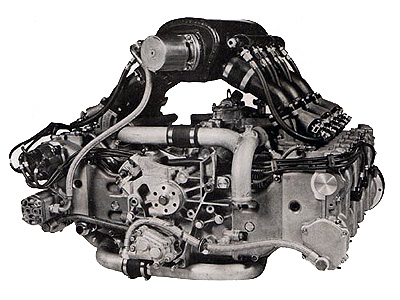 1978‐79: Porsche 935/72 1980年代後半になるとゼネラルモーターズがシボレー・ブランドで参戦を開始し、88年から6連勝して、フォード・コスワース全盛時代を終わらせた。
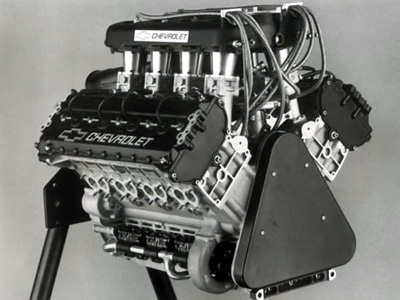 1988 Chevrolet by Ilmor この時代はポルシェ、メルセデス・ベンツ、アルファロメオ、ホンダがインディ500にチャレンジしたが、勝利したのは94年のメルセデス・ベンツだけであった。
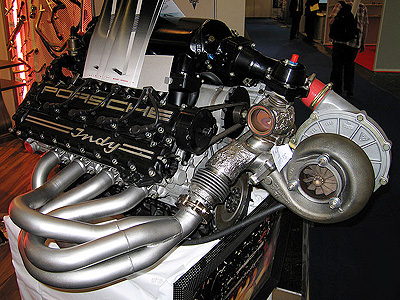 1988: Porsche V8
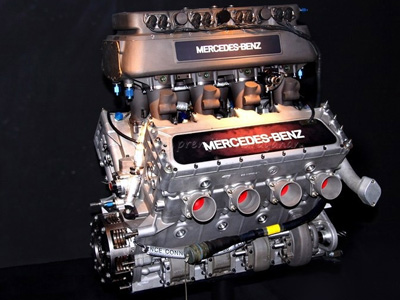 1994: Mercedes Benz 500i
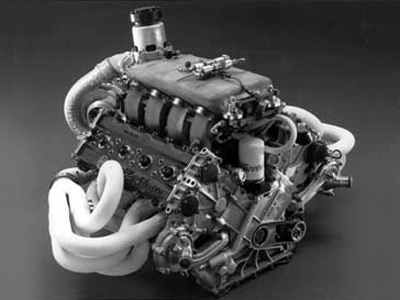 1989: Alfa Romeo
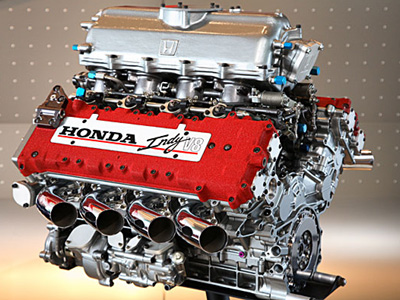 1994: HONDA
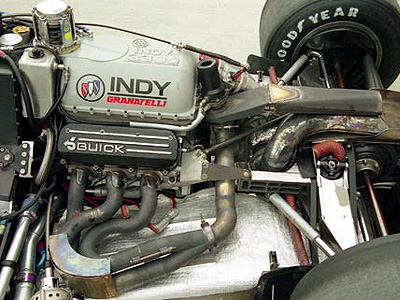 1990 Penske Buick
1979-1995: CART -> 1996-2008: Champ car1979年より、CART (Championship Auto Racing Teams) が、インディカーと呼ばれるオープンホイールマシンを用いた同名のチャンピオンシップシリーズを運営していた。世界三大レースのひとつで当時CARTの1ラウンドを構成していたインディ500を主催するインディアナポリス・モーター・スピードウェイ (IMS) がCARTの運営に不満を持ち、1994年、IMSが1996年より新しいカテゴリーを発足させる旨の発表し、1996年、2つのシリーズに分裂した。 CART側はインディ500をシリーズカレンダーから除き、それまでのレギュレーションのレースを維持する一方で、IMS側は新たにインディ・レーシング・リーグ (IRL) を設立し、インディ500を中心としたオーバルレース専門のレースを運営することになった。 それにより、今までインデ・カーとよばれていたCART用のマシンがチャンプ・カー (Champ Car) と変更され、インディ・カーはIRL側のマシンの呼称となった。 名門ペンスキーの離脱やエンジン規定を巡るいざこざで、2002年をもってトヨタ、ホンダが撤退、両社は2003年にIRLへ移籍した。またそれまでの参戦チーム、ドライバーも多数IRLへと移籍。2007年シリーズ開幕前のフォードのタイトルスポンサー降板などの影響をうけ、CARTは破産する。 その後チャンプカー・ワールドシリーズ (CCWS) として再生を図っていたが、2008年シーズンからIRLとシリーズを統合することが決定(事実上IRLによる吸収)し、2008年4月20日にロングビーチ市街地コースで行われるレースを最後にシリーズが終了した。
1979-1995: CART -> 1996-: IRL (Indy Racing League)1996年、CARTから分裂し、現在のインディカー・シリーズが発足すると、フォード、ビュイック、オールズモビル、インフィニティが覇を競ったが、オールズモビルが圧勝した。
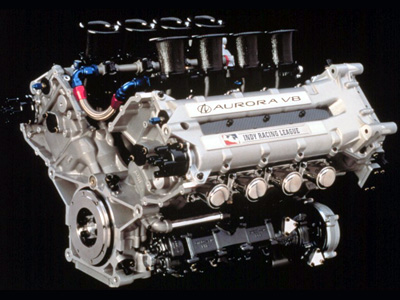 Oldsmobile Aurora by Ilmor インディカー・シリーズ発足当初はCART同様の2.65L V8 ターボエンジンを使用していたが、1997年より3.5L V8 NAエンジンに変更される。 2002年まではシボレー(2001年まではオールズモビル・オーロラの名で供給)とインフィニティの2社がエンジンを供給していた。インフィニティは2002年限りで撤退、2003年よりChamp carからトヨタ、ホンダが移籍してきて、シボレー、ホンダ、トヨタの3社となった。
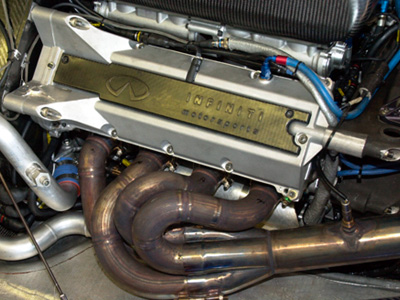 2002 Infinity VRH35A 2003年のシーズン途中からはシボレーエンジンの開発をコスワースが担当するようになった。 2004年の第4戦(インディ500)からはエンジン排気量の上限を3Lに改められた。 2005年限りでシボレー、トヨタが撤退するまで、王者シボレーと新規参入の日本勢の3つどもえが見物となったが、2003年はトヨタが勝利、2004年から2005年はホンダが連覇した。
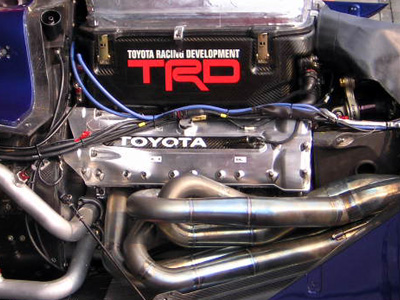 2005 TOYOTA V8 2006年から2011年まで、実質上、ホンダ Indy V8エンジンのワンメイクとなった。
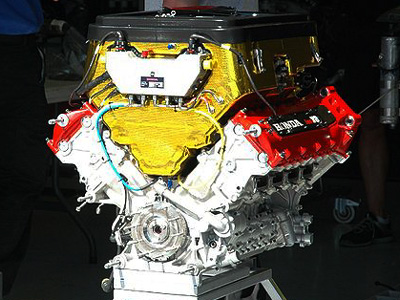 2008 HONDA V8 2012年から2.2L以下 6気筒以下 ツインターボ 直噴エンジンを採用する。サプライヤーは前年から継続して供給するホンダ、7年振りに復帰したシボレー(実際の開発はイルモア)、そしてジャッドと提携するグループ・ロータスの3社。 燃料は2007年シーズンよりエタノール98%・ガソリン2%の混合燃料が使用されている。 |
1992 XB
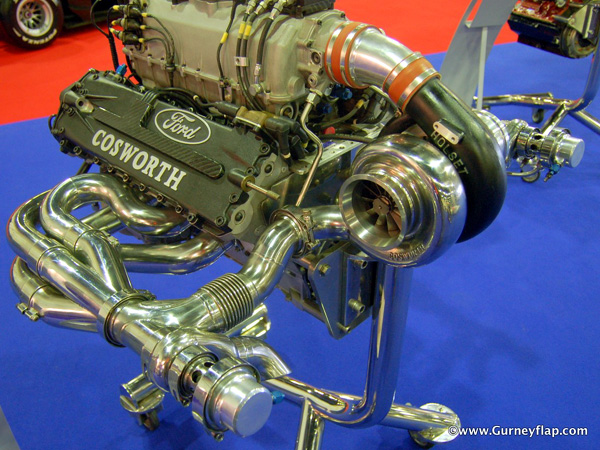
Cosworth designed a series of replacements for the DFS to be used in IndyCar and Champ Car racing: the X-series, beginning in 1992 with the XB.
The XB is a 2.65 liter V-8 burning methanol and producing in excess of 750 horsepower at 12,000 RPM and 7.35 psi of boost. Last run was in mass in 1995; with but a few teams running the engine in 1996.
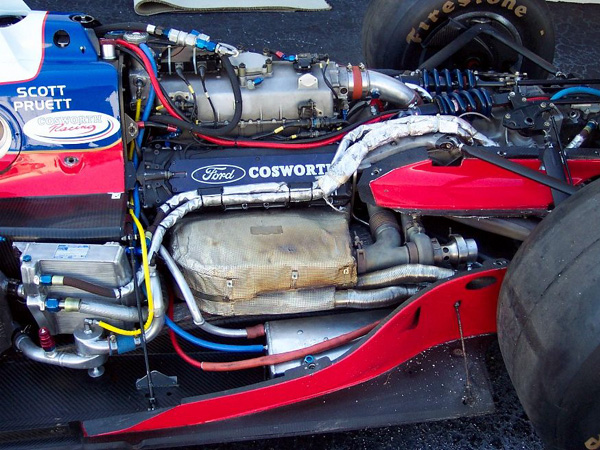
The XB engine burst onto the Indy car scene in 1992 to re launch Cosworth as a major player and that was the foundation for a family of engines which are still in use today. The XB was a success both on and off the track and sales of this unit led directly to Cosworth being awarded the Queens Award for Export Achievement.
Nigel Mansell's 1993 CART championship and Jacques Villeneuve's 1995 Indy 500 win were both provided by Cosworth power.
1996 XD
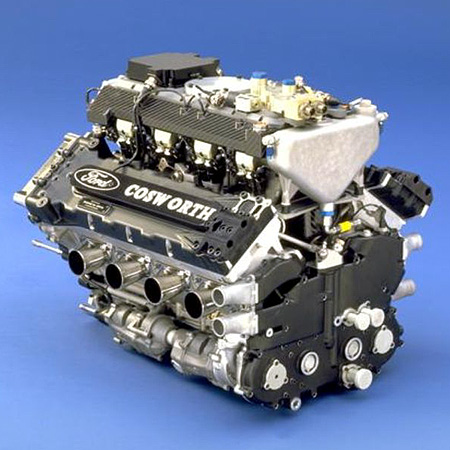
The Cosworth XD was introduced in 1996 and ran through 1999. It was replaced by the XF (and in 2003 XF-E). It is a 2.65 liter V-8 burning methanol and producing in excess of 800 horsepower at 13,000 RPM and 4.9 psi of boost. For reference, boost is measured in inches of mercury absolute pressure.
2000 XF
The XF was developed for the 2000 season to replace the XD, and was chosen as the spec engine for the Champ Car World Series in 2003.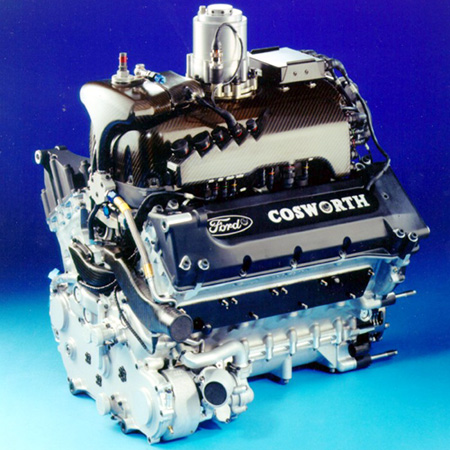
In 2000 Cosworth won the inaugural CART manufacturers championship and two years later secured a groundbreaking relationship with the organization to become the exclusive engine supplier to the series. Success also continued in the wider business arena and in 2003 Cosworth was voted the MIA business of the year.
2003 XFE
Over the years Ford Cosworth has produced more than forty different racing engines, including the legendary DFV V8, winner of 154 F1 races between 1967-'83, and the DFX turbo V8 USAC/CART engine, winner of 151 Champ car races between 1976-'89, as well as the highly successful XB, XD and XF turbo V8s of the modern era. The XB, XD, XF and XFE have added 104 more wins since 1992 to produce a staggering grand total of 255 Champ car wins.In 2008, the new Cosworth XF engine, previewed as a powerful powerhouse engine, will be a key component in the rebirth of the Champ Car engine formula for 2009 and, as everyone knows, over the past four years the current XFE turbo V8 has been the savior of Champ Car racing. The engine's turbo wail is a defining factor of the Champ Car World Series and its traction control-free performance is a pleasure to watch.
Originally developed in no-holds-barred competition with Honda, Toyota and Mercedes-Benz, the XF was turning more than 16,000 rpm and churning out more than 900 horsepower in 2001 despite a very restrictive boost limit. The current XFE was designed for durability and is limited to 15,000 rpm and required to run 1,200 miles between rebuilds. The XFE has been a huge success but Cosworth is always looking ahead and XF design chief Bruce Wood has been overseeing plans to increase power in 2009 up to 18,000 rpm and over 950 horsepower when Cosworth builds Champ Car's new XFE-2 V8 Turbocharged engine in company with the introduction of the DP01 spec 2 Champ car.
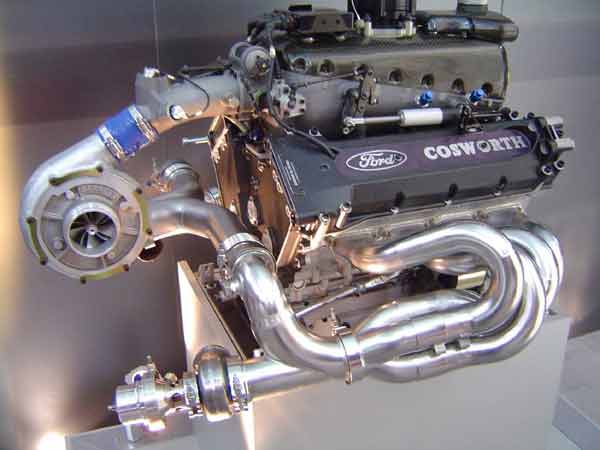
The most recent derivative of the XF, the 2,650 cc XFE quad-cam 90° V8 overhead camshaft, continued in that role through the 2007 season.
The Champ Car World Series imposed a rev limit of 12,000 rpm down from the over 15,000 rpm of 2002.
In 2004, Cosworth was purchased by Gerry Forsythe and Kevin Kalkhoven, co owners of the Champ Car World Series (successor to CART)
The 2004 model of the XFE had a rated power of nominal 750 horsepower (559 kW; 760 PS) at 1,054 mmHg (intake boost pressure), and a maximum power of 800 bhp (597 kW; 811 PS) at 1130 mmHg (during Push-to-Pass). The 2004 XFE maximum speed was 12,000 rpm (rev limited) and torque of 490 newton metres (361 ft・lbf). The aluminium and iron turbo housing ran a boost of 5.9 psi at sea level (= boost of 12 inches of mercury which is 41.5 inches of mercury absolute).
The Methanol-fuelled engine used a steel crankshaft and aluminium alloy pistons. Weight was 120 kilograms (264.6 lb) and length was 539 millimetres (21.2 in).
In 2007, the Ford name was removed from the engine pieces as the manufacturer elected not to continue sponsorship of the series. Several other engine changes were made, notably the removal of the calibrated "pop off valve" designed to limit turbo boost pressure, replaced by engine electronics.
The rated life of the engine was 1,400 miles (2,300 km) between rebuilds. Engines were sent by the race teams to Cosworth for the rebuild.
In 2007, Champ Car switched to the new Panoz DP01 chassis, which was said to provide better ducting of airflow into the engine.
The Champ Car World Series merged into the Indy Racing League IndyCar Series prior to the 2008 season.
2009 XFE-2
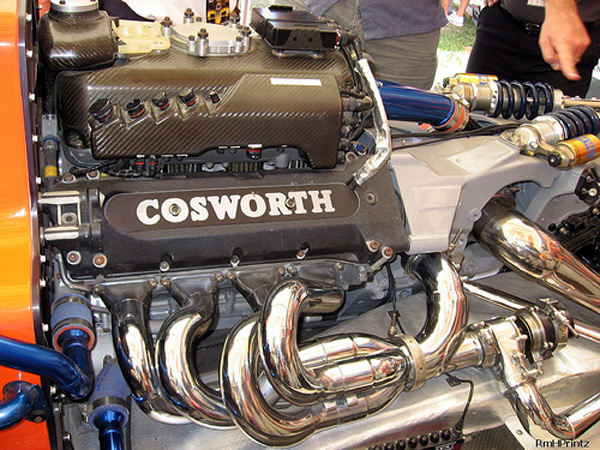
2009 Champ Car World Series Cosworth XFE-2 Turbocharged
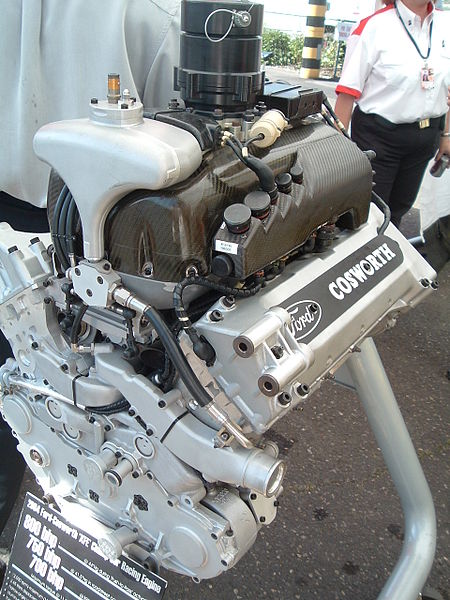
The pop off valve & ECU black box regulate turbo boost on a Champ Car
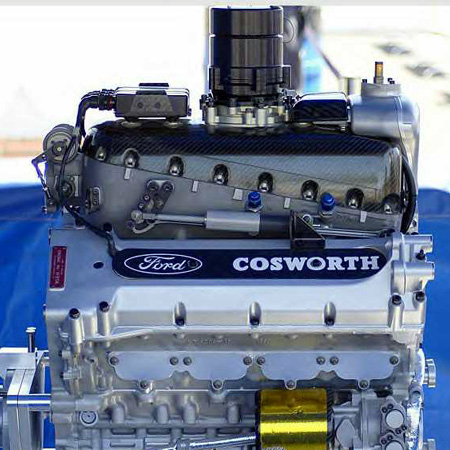
Ford Cosworth Engineering both design and build Champ Car's 950 horsepower turbocharged engines
XG "Chevworth"
2003年のシーズン途中から、INDY用シボレーエンジンの開発を手掛けた。
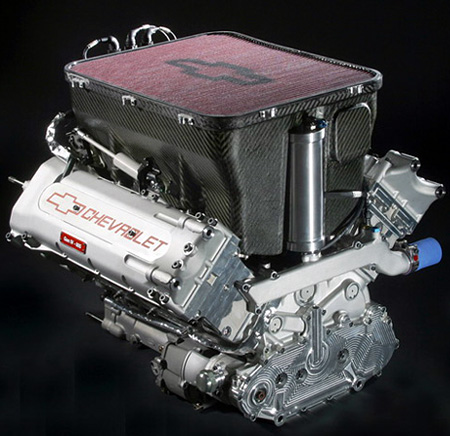
3.5L XG - Chevrolet Gen 4 by Cosworth
In mid 2003, Cosworth provided the 3.5 L V8 XG badged as a Chevrolet Gen 4 engine to IRL IndyCar Series teams after the proprietary Chevrolet Gen 3 engine proved inadequate against rival Hondas and Toyotas during the 2003 season.
While many teams left Chevrolet after the 2003 season, those that stayed saw a significant improvement in performance with the new "Chevworth" engine compared to their previous units.
The XG finished second in its first race at Michigan on July 27, 2003. Sam Hornish, Jr. went on to win 3 races that season with the new XG.
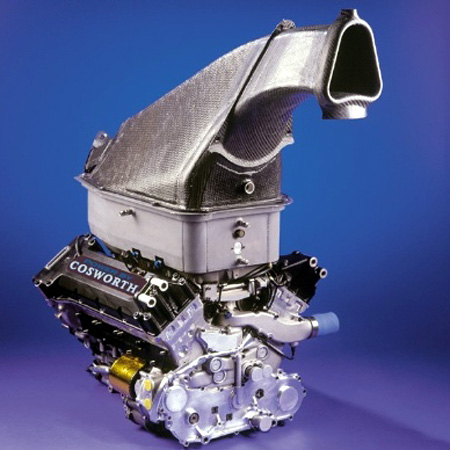
3.0L New XG
The XG was reduced in size to 3 L for 2004 season and it won one race in 2005 during Chevrolet's final season in IRL.
CD - 3.4L OHV - never completed
There is evidence that Cosworth was working on a 3,400 cc push-rod V8 along the lines of the Ilmor/Mercedes 500I to exploit the peculiar loophole in the Indianapolis 500 rules permitting such engines higher turbocharger boost - this was assigned a project code (CD) but seemingly never completed.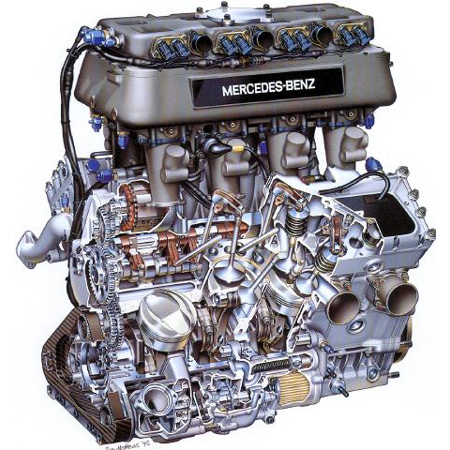
イルモア製 OHV 2バルブ V8